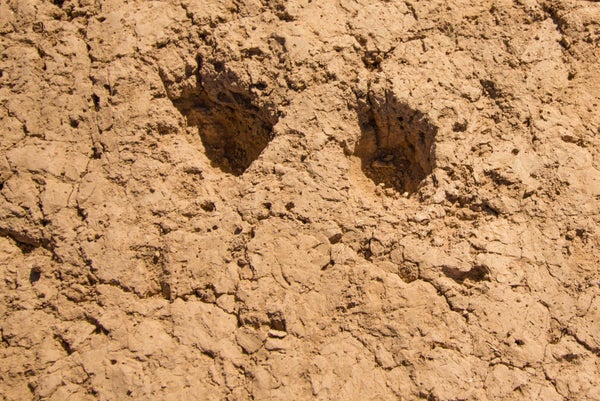The recent discovery of dozens of remarkably well-preserved footprints in the southern Arizona desert provides new insights into how Native people practiced a complex system of irrigation agriculture in the region between 2,500 and 3,000 years ago. The find also offers new evidence in a long-standing debate over possible migration patterns from Mesoamerica and gives a unique snapshot of daily life at a time when people were transitioning from nomadic hunter–gatherers to more sedentary village dwellers.
The footprints, among the oldest ever found in the Southwest, were discovered last December during the preconstruction mitigation phase of a bridge project in Tucson, says Ian Milliken, an archaeologist for the Pima County Office of Sustainability and Conservation. The prints show what appears to have been a family—two adults, two children and a dog—opening and closing headgates from a raised irrigation ditch into fields measuring 15 meters by 15 meters. “They’re exponentially larger than anything we’ve discovered for this time period,” Milliken says. “What’s really unique about this is that it actually captures a point in time, probably down to the day these prints were left.”
The finding is important, says Paul Fish, curator emeritus of the Arizona State Museum at the University of Arizona in Tucson, because it supports the theory that irrigation agriculture in Arizona was a homegrown technique, not the result of a migration of people out of Mesoamerica. “The presence of well-developed irrigation strategies in the Tucson Basin by 1500 B.C.,” Fish says, “strongly indicates the that large-scale canal technologies of the Phoenix Basin Hohokam developed locally.” Between about A.D. 200 to around 1450, when they disappeared, the Hohokam built more than 240 kilometers of canals throughout the Salt River Valley in what is now Phoenix, a feat of agricultural engineering unsurpassed in Mesoamerica.
On supporting science journalism
If you're enjoying this article, consider supporting our award-winning journalism by subscribing. By purchasing a subscription you are helping to ensure the future of impactful stories about the discoveries and ideas shaping our world today.
Allen Denoyer, with Archaeology Southwest, a subcontractor working with SWCA Environmental Consultants, the firm excavating the Tucson site, says that the recently discovered fields are “clearly a local adaptation.” But Denoyer does not rule out the possibility that the techniques used there originated in Mesoamerica and could have been introduced by people spreading north along river valleys.
The theory that Hohokam settlement of southern Arizona was the result of a migration out of Mexico was based in large part on the scale and complexity of the Hohokam irrigation system. Fish finds that theory unconvincing on two counts, however. Mesoamerican irrigation systems are no older than their counterparts in Phoenix, he says. Also, many other Mesoamerican cultural and technological influences found among the Hohokam appeared at about the same time as they did in the south, with no evidence of their existence on the land in between. A more likely scenario, Fish argues, is that forms of interaction with peoples to the south involved individuals traveling from north to south to obtain Mesoamerican ritual items and knowledge that would elevate their status back home.
Ian Milliken does not expect the new discovery to settle the debate: “We have evidence of very early agriculture in Mexico that predates this, but that doesn’t mean it wasn’t here at the same time.” It is also possible that the same agricultural techniques were widespread but did not leave a trace elsewhere. “The U.S. east coast may have had early irrigation agriculture but you’re just not seeing any remnants of it because of more soil moisture there,” Milliken says. “It could just be that we get this preservation effect here because of the desert.
The recently discovered footprints owe their existence to a unique set of circumstances, Denoyer says. Soon after they were made, flooding from a nearby river deposited a layer of micaceous sand 10 to 20 centimeters deep across the field. When the field was reused, the sand-filled prints were so well preserved that it was possible to see where mud squeezed into the small spaces between their individual toes—or in the case of the dog, between claws.
Archaeological excavation of fields in the Southwest is still a relatively recent development, with previous digs focusing on structures, which are more easily found with technologies like ground-penetrating radar. That changed in 1988 when fields were unearthed during a similar road project just two and a half kilometers from where the footprints were found.
Archaeologists expect to discover more about the lives of these ancient people in the near future. “We’ve got five stratified layers below this one,” says Milliken, pointing to a pair of tiny parallel footprints made by a child standing at the edge of the field thousands of years ago. “There’s so much more to learn.”
